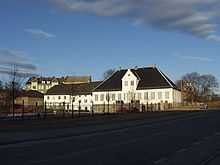Old Bishop's Palace in Oslo
The Old Bishop's Palace in Oslo was the residence of the Catholic bishops of Oslo. The palace was built like a fortified castle. The construction was begun around 1210 by the then bishop, Nikolas Arnesson, continuing through to the early 14th century. The palace built in stone replaced a previous bishop's residence built in wood, established in the 12th century.
The palace is located in what is now called Gamlebyen (the old town) in Oslo. The main buildings were surrounded by tall walls, and from a tower, a wooden bridge connected the palace to the neighboring Hallvards Cathedral.
Together with the cathedral, the palace was not only a religious centre in Middle Age Oslo, it was also of significant political importance. The first agreement of union between Norway and Sweden was signed in the bishop's palace just after the death of Håkon V of Norway, in 1319.

The palace was damaged after Swedish attacks in 1523, and after the reformation in 1537 large parts of the palace were torn down. In 1554 the Protestant bishop moved to the current bishop's residence in Oslo, a former monastery.
In 1579 the then mayor of Oslo, Christen Mule, built a Renaissance building on the ruins of the previous bishop's palace, and in this building King James VI of Scotland married princess Anne of Denmark on November 23, 1589.
After a fire in 1722, the current Oslo Ladegård was built on the foundation of Mule's palace in 1725.
Various remnants of the medieval bishop's palace are still visible.
Notes
Coordinates: 59°54′22.27″N 10°46′3.02″E / 59.9061861°N 10.7675056°E